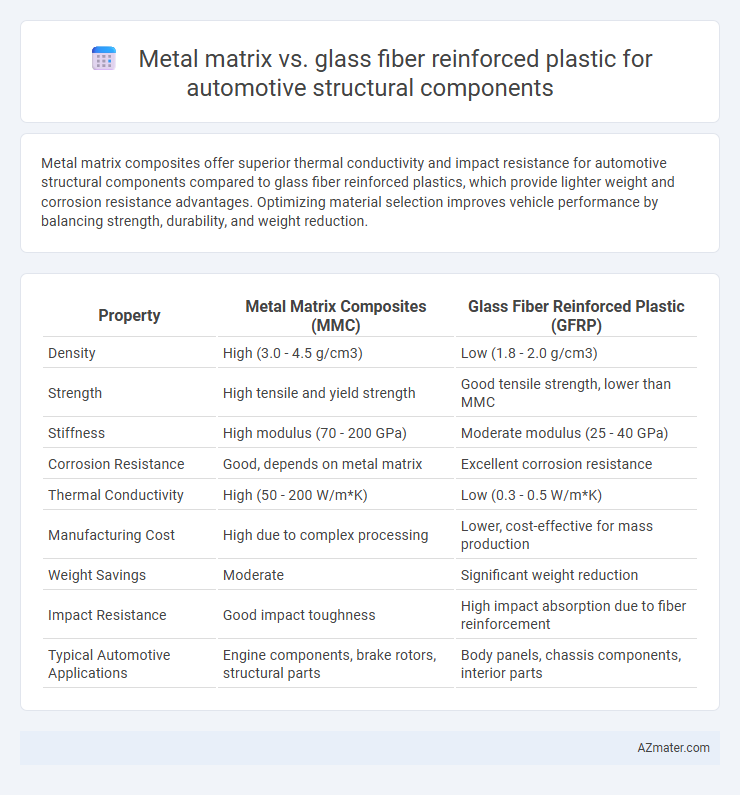Metal matrix composites offer superior thermal conductivity and impact resistance for automotive structural components compared to glass fiber reinforced plastics, which provide lighter weight and corrosion resistance advantages. Optimizing material selection improves vehicle performance by balancing strength, durability, and weight reduction.
Table of Comparison
| Property | Metal Matrix Composites (MMC) | Glass Fiber Reinforced Plastic (GFRP) |
|---|---|---|
| Density | High (3.0 - 4.5 g/cm3) | Low (1.8 - 2.0 g/cm3) |
| Strength | High tensile and yield strength | Good tensile strength, lower than MMC |
| Stiffness | High modulus (70 - 200 GPa) | Moderate modulus (25 - 40 GPa) |
| Corrosion Resistance | Good, depends on metal matrix | Excellent corrosion resistance |
| Thermal Conductivity | High (50 - 200 W/m*K) | Low (0.3 - 0.5 W/m*K) |
| Manufacturing Cost | High due to complex processing | Lower, cost-effective for mass production |
| Weight Savings | Moderate | Significant weight reduction |
| Impact Resistance | Good impact toughness | High impact absorption due to fiber reinforcement |
| Typical Automotive Applications | Engine components, brake rotors, structural parts | Body panels, chassis components, interior parts |
Introduction to Automotive Structural Materials
Metal matrix composites (MMCs) offer superior strength-to-weight ratios and thermal stability compared to traditional metal alloys, making them ideal for automotive structural components subjected to high stresses. Glass fiber reinforced plastics (GFRP) provide excellent corrosion resistance, lightweight properties, and good impact absorption, enhancing vehicle fuel efficiency and crash safety. The selection between MMCs and GFRPs depends on specific performance requirements such as load-bearing capacity, durability, and manufacturing cost in automotive design.
Overview of Metal Matrix Composites (MMCs)
Metal Matrix Composites (MMCs) combine metal alloys with reinforcing materials such as ceramic fibers or particles, offering superior strength-to-weight ratios and enhanced thermal conductivity compared to Glass Fiber Reinforced Plastics (GFRP). MMCs exhibit excellent wear resistance, high stiffness, and improved dimensional stability, making them ideal for automotive structural components requiring durability and lightweight performance. Their ability to maintain mechanical properties at elevated temperatures provides significant advantages over GFRP in under-hood and chassis applications where heat resistance is critical.
Overview of Glass Fiber Reinforced Plastic (GFRP)
Glass Fiber Reinforced Plastic (GFRP) is a composite material consisting of a polymer matrix reinforced with glass fibers, offering high strength-to-weight ratio and excellent corrosion resistance ideal for automotive structural components. Its lightweight nature significantly enhances fuel efficiency and reduces emissions compared to traditional metal matrices like steel or aluminum. GFRP also provides superior impact resistance and design flexibility, making it a preferred choice for complex geometries in modern vehicle manufacturing.
Mechanical Properties: Strength and Stiffness Comparison
Metal matrix composites exhibit higher tensile strength and superior stiffness compared to glass fiber reinforced plastics, making them ideal for applications requiring enhanced load-bearing capacity in automotive structural components. Glass fiber reinforced plastics offer lower density and better corrosion resistance but generally provide reduced stiffness and strength relative to metal matrix materials. The mechanical performance advantages of metal matrix composites translate into improved durability and structural integrity under dynamic and high-stress automotive conditions.
Weight Reduction and Density Analysis
Metal matrix composites offer higher density but superior mechanical strength compared to glass fiber reinforced plastics, impacting overall vehicle weight and performance. Glass fiber reinforced plastics exhibit significantly lower density, contributing to weight reduction and improved fuel efficiency in automotive structural components. Evaluating density and stiffness-to-weight ratio is crucial for selecting materials that optimize structural integrity while minimizing vehicle mass.
Corrosion and Environmental Resistance
Metal matrix composites (MMCs) offer superior mechanical strength but are prone to corrosion when exposed to automotive environmental conditions, requiring protective coatings for durability. Glass fiber reinforced plastics (GFRPs) demonstrate excellent corrosion resistance and environmental stability, making them ideal for components exposed to moisture, chemicals, and UV radiation. The inherent corrosion resistance of GFRPs reduces maintenance costs and enhances long-term performance in automotive structural applications.
Manufacturing Processes and Cost Implications
Metal matrix composites (MMCs) involve processes such as powder metallurgy, stir casting, and infiltration, which require high-temperature equipment and precise control, leading to elevated manufacturing costs compared to glass fiber reinforced plastics (GFRP). GFRP manufacturing typically uses resin transfer molding, compression molding, or filament winding, offering lower energy consumption and faster cycle times, resulting in reduced production costs. The cost implications favor GFRP for mass-produced automotive structural components due to cheaper raw materials and scalable processes, while MMCs provide superior mechanical performance but with higher expense and complexity.
Durability and Fatigue Performance
Metal matrix composites exhibit superior durability and fatigue performance in automotive structural components due to their high strength-to-weight ratio and excellent thermal stability. Glass fiber reinforced plastics offer good fatigue resistance with corrosion resistance but typically have lower impact strength and stiffness compared to metal matrix composites. Advanced metal matrix materials maintain integrity under cyclic loading and harsh environmental conditions, making them preferable for critical automotive applications requiring long-term durability.
Design Flexibility and Application Examples
Metal matrix composites (MMCs) offer excellent design flexibility due to their high strength-to-weight ratio and thermal stability, making them ideal for engine components and brake systems in automotive structures. Glass fiber reinforced plastics (GFRP) provide superior versatility with complex shapes and lightweight properties, commonly applied in body panels, interior parts, and structural reinforcements. The choice between MMCs and GFRP hinges on balancing mechanical performance requirements with manufacturing constraints in structural automotive design.
Future Trends and Material Selection Guidelines
Future trends in automotive structural components emphasize the shift towards lightweight, high-strength materials, with metal matrix composites (MMCs) offering superior thermal conductivity and stiffness compared to glass fiber reinforced plastics (GFRP). Material selection guidelines prioritize specific mechanical properties such as tensile strength, impact resistance, and fatigue performance, while considering cost-effectiveness, recyclability, and manufacturing scalability. Advances in MMC processing techniques and hybrid composites integrating glass fibers aim to balance performance optimization with sustainability requirements in next-generation vehicle design.

Infographic: Metal matrix vs Glass fiber reinforced plastic for Automotive structural component
 azmater.com
azmater.com